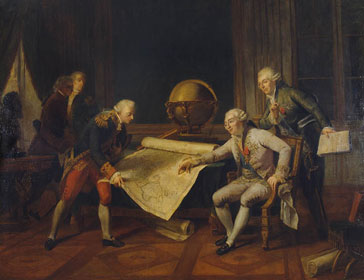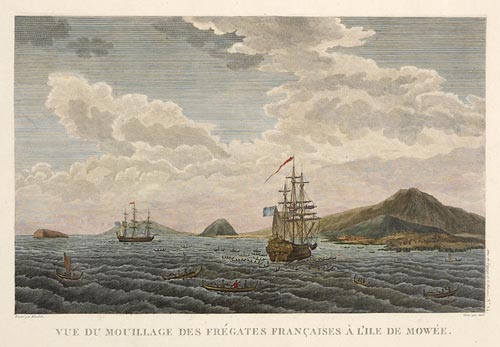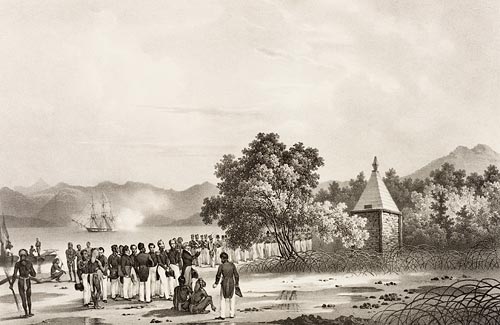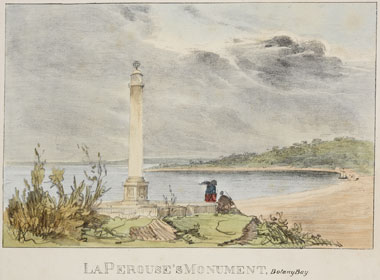The fate of La Perouse
In 1785, Jean-Francois de Galaup, Comte de la Perouse, began preparations for an extensive sea voyage. His aim was to explore the Pacific regions of North and South America, Asia and Australasia. The sponsor of the expedition was the French king, Louis XVI, who was inspired by Captain James Cook's Pacific voyages. Louis ordered the French expedition to show the world that France could also dominate in ocean exploration.
Louis XVI giving final instructions to the Comte de la Perouse, 1785, by Edouard Nuel
Oil painting ML 39
The expedition consisted of two ships - La Boussole and L'Astrolabe. They carried a total of 225 crew, officers and scientists. The ships left France in August 1785 and sailed south around Cape Horn. The voyage was expected to last four years.
> View a map showing the route taken by the La Perouse expedition
During the voyage, La Perouse sent back regular reports to France. The expedition mapped coastlines and explored uncharted areas of ocean. The expedition's scientists also spent time onshore at various ports, observing the habits and customs of local people and collecting natural history specimens. The expedition's progess until September 1787 was published by the French government as Voyage de La Perouse autour du monde [La Perouse's voyage around the world]. It was reprinted many times and translated into several languages.
> View the plates from Voyage de La Perouse autour du monde ![]()
The French Frigates from Voyage de La Pérouse autour du monde publié conformément au décret du 22 avril 1791, et rédigé par M. L.A. Milet-Mureau, 1798, A Paris : Chez Plassan, Imprimeur-Libraire
Printed volume X980/ 3A
On 20 January 1788, the First Fleet arrived in Botany Bay. The British believed they were completely isloated from any other European presence. Just four days later however, Philip Gidley King recorded in his journal:
'...two Strange Ships were seen standing in the Bay ... we judged them to be the two Ships under the orders of Monsieur de la perouse.'
> Read more of Gidley King's journal describing the French-British encounter
La Perouse's ships sailed out of Botany Bay in March 1788. The British lookout on South Head saw them leave. This was probably the last time the French expedition was seen by Europeans.
The French government received no further communication from La Perouse after the expedition left Botany Bay. It seemed as if the two ships had disappeared completely. A rumour circulated that La Perouse had been seen at Manila, although this was never verified.
> View a letter from Frenchman Jean Baptiste Mongez reporting the rumoured sighting of La Perouse
In 1791, when La Perouse had not returned to France or made any contact by dispatch, the French government sent out a search party. It was commanded by Rear Admiral Joseph Antoine Bruni d'Entrecasteaux and consisted of two ships, Recherche and Esperance.
> See French laws relating to the search for La Perouse
As well as searching for the lost La Perouse expedition, d'Entrecasteaux's party also carried out scientific research. The botanist on the expedition, Jacques Labillardiere, published an account of the voyage.
> Examine the plates from Labillardiere's atlas
Despite the extensive search carried out by d'Entrecasteaux, he failed to find any trace of the missing French ships.
The complete disappearance of La Perouse caught the imagination of the European public. Songs, stories and plays were written about the possible fate of the expedition, including a popular play called, Perouse, or, The desolate island.
> Explore a contemporary broadside advertising a performance of Perouse and a description of the play
In 1826, an Irish captain, Peter Dillon, was in the Santa Cruz Islands (now part of the Solomon Islands). Here he bought several swords which he believed had belonged to La Perouse. According to locals, the swords had come from a nearby island called Vanikoro where two large ships had broken up. Among the reefs of Vanikoro, Dillon, and later Dumont d'Urville, discovered anchors and other wreckage. These remains were identified as belonging to L'Astrolabe.
Dumont D'Urville and monument from Voyage de la corvette l'Astrolabe : exécuté par ordre du roi, pendant les années 1826, 1827, 1828, 1829…,
Printed volume RB/ RF990A/ 41
No crew members were ever found, although locals on Vanikoro told Dillon that some of the survivors had built a boat and sailed away, and at least two men allegedly remained for many years on Vanikoro but had died or left some time earlier. Dumont d'Urville oversaw the erection of a monument to the La Perouse expedition on Vanikoro.
It was not until 1964 that the wreck of La Boussole was finally discovered on Vanikoro's reefs. At last the fate of La Perouse and his crew was known.
The expedition is commemorated in the name of a Sydney suburb on the shores of Botany Bay - La Perouse.
La Perouse's monument, Botany Bay, c.1836, by J.G. Austin & Co.
Hand-coloured lithograph DL Pd 14











